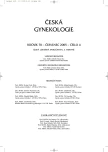TNF-α Serum Levels in Women with Endometriosis: Prospective Clinical Study
Authors:
S. Galo 1; P. Žúbor 1; N. Szunyogh 1; K. Kajo 2; K. Macháleková 2; K. Biringer 1; J. Višňovský 1
Authors‘ workplace:
Gynekologicko-pôrodnícka klinika JLF UK a MFN, Martin, Slovenská republika, prednosta prof. MUDr. J. Danko, CSc.
1; Ústav patologickej anatómie JLF UK a MFN, Martin, Slovenská republika, prednosta prof. MUDr. L. Plank, CSc.
2
Published in:
Ceska Gynekol 2005; 70(4): 286-290
Category:
Original Article
Overview
Objective:
To determine serum levels of TNF-α (tumor necrosis factor alpha) as a prediction of endometriosis.
Design:
Prospective clinical case control study.
Setting:
Department of Obstetrics and Gynaecology and Department of Pathology, Jessenius Faculty Hospital, Kollarova 2, Martin, Slovakia.
Methods:
The serum TNF-α was determined in women who underwent laparoscopy or laparotomy due to pelvic pain, infertility, dysmenorea or pelvic tumor. Endometriosis was confirmed histologically and classified by rAFS.
Results:
On the basis of entering criteria 65 women were enrolled in this study. In 61 cases serum level of TNF-α was evaluated. The average serum level of TNF-α in the endometriotic group was 73.847 pg/ml (n=30) and without endometriosis was 21.089 pg/ml (n=31). We have found a significant statistical difference between the above mentioned groups in the medium levels of TNF-α (p<0.0001). We did not find statistical significance between TNF-α levels and in the group of women with endometriosis in relation to the stage of the disease (I.–II., III.–IV., adenomyosis). At a cut-off level of TNF-α 30 pg/ml there was a 63.33% sensitivity, 77.42% specificity, a positive prediction value 73.07%, and 68.57% of negative predictive value.
Conclusion:
TNF-α serum levels are good diagnostic markers of endometriosis in the spectrum of noninvasive methods.
Key words:
TNF-α, endometriosis, adenomyosis, pelvic pain
Labels
Paediatric gynaecology Gynaecology and obstetrics Reproduction medicineArticle was published in
Czech Gynaecology

2005 Issue 4
Most read in this issue
- Prenatal Parvovirus B19 Infection in Fetus
- The Detection of p16 Protein in Uterine Cervix Lesions
- Changes in Vesicalization of Urethra and Bladder after TVT Operation
- Antibiotics prophylaxis in laparoscopy
